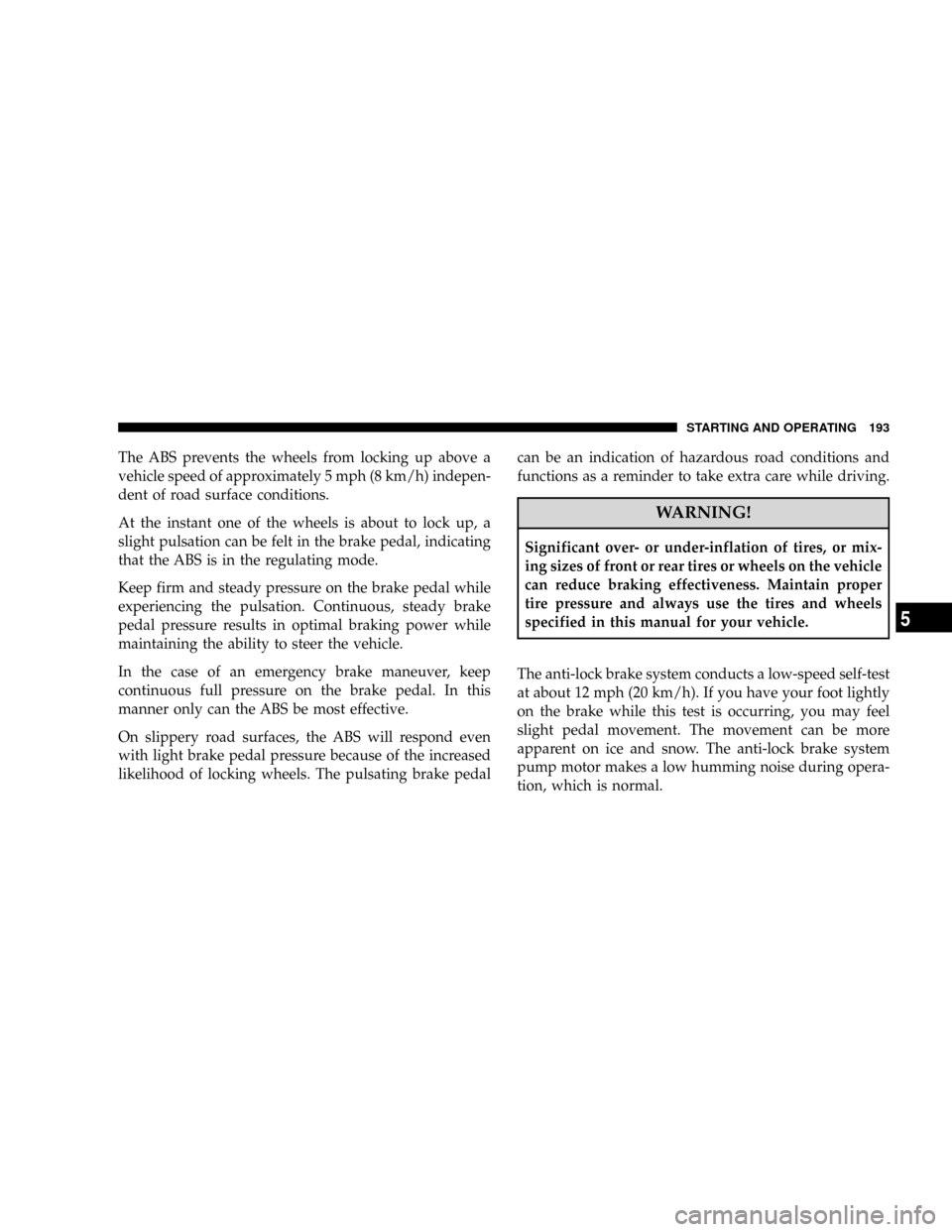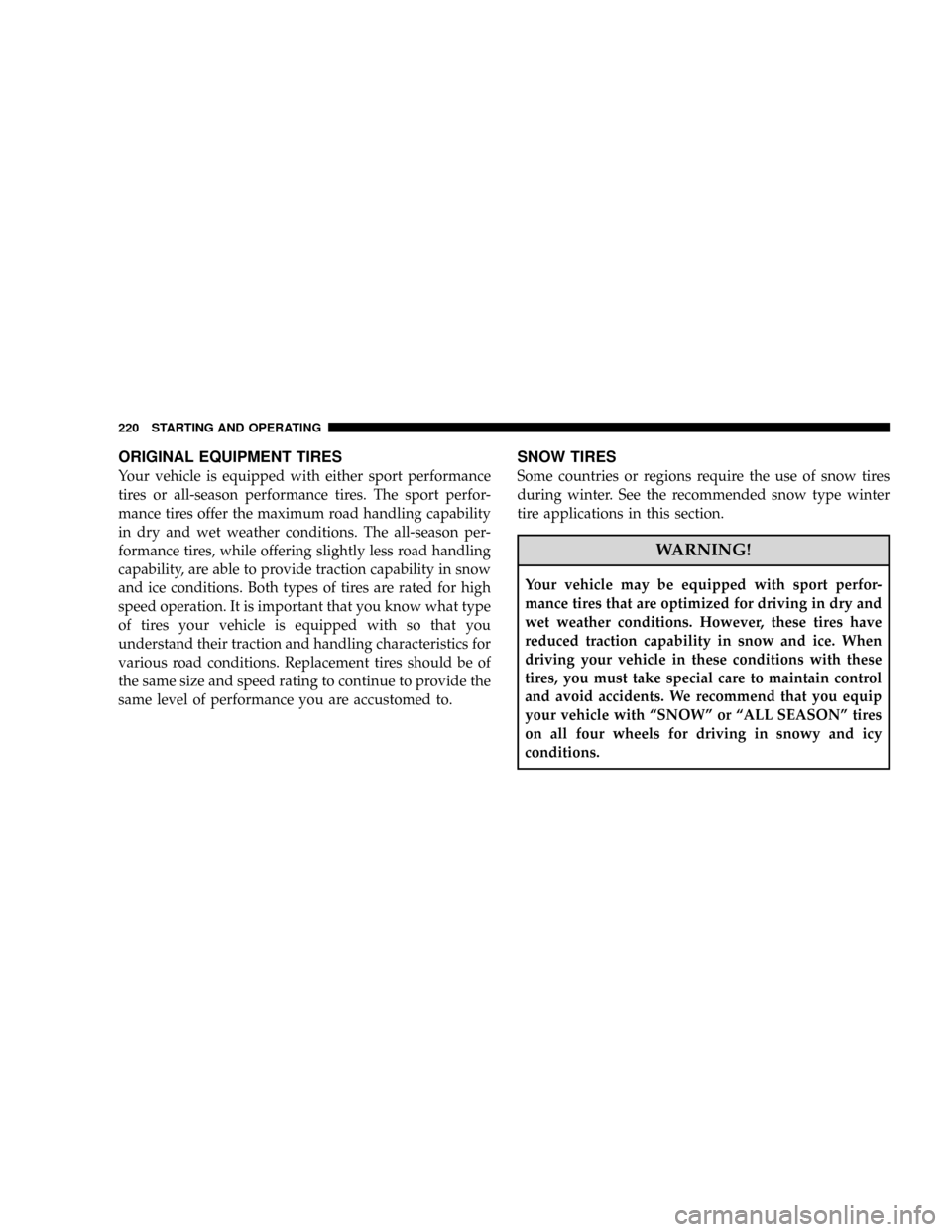2008 CHRYSLER CROSSFIRE wheel size
[x] Cancel search: wheel sizePage 41 of 358

WARNING!
Do not put anything on or around the airbag covers
or attempt to manually open them. You may damage
the airbags and you could be injured because the
airbags are not there to protect you. These protective
covers are designed to open only when the airbags
are inflated.
²TheDriver and Passenger Airbag/Inflator Unitsare
located in the center of the steering wheel and the right
side of the instrument panel. When the ORC detects a
collision requiring the airbags, it signals the inflator
units. A large quantity of nontoxic gas is generated to
inflate the front airbags. Different airbag inflation rates
may be possible based on collision severity and occu-
pant size. The steering wheel hub trim cover and theupper right side of the instrument panel separate and
fold out of the way as the bags inflate to their full size.
The bags fully inflate in about 50±70 milliseconds. This
is about half of the time it takes to blink your eyes. The
bags then quickly deflate while helping to restrain the
driver and front passenger. The driver 's front airbag
gas is vented through vent holes in the sides of the
airbag. The passenger 's front airbag gas is vented
through vent holes in the sides of the airbag. In this
way the airbags do not interfere with your control of
the vehicle.
²The Knee Blocker Airbag helps protect the knees and
working with the seat belts, position you for the best
interaction with the airbags.
THINGS TO KNOW BEFORE STARTING YOUR VEHICLE 39
2
Page 195 of 358

The ABS prevents the wheels from locking up above a
vehicle speed of approximately 5 mph (8 km/h) indepen-
dent of road surface conditions.
At the instant one of the wheels is about to lock up, a
slight pulsation can be felt in the brake pedal, indicating
that the ABS is in the regulating mode.
Keep firm and steady pressure on the brake pedal while
experiencing the pulsation. Continuous, steady brake
pedal pressure results in optimal braking power while
maintaining the ability to steer the vehicle.
In the case of an emergency brake maneuver, keep
continuous full pressure on the brake pedal. In this
manner only can the ABS be most effective.
On slippery road surfaces, the ABS will respond even
with light brake pedal pressure because of the increased
likelihood of locking wheels. The pulsating brake pedalcan be an indication of hazardous road conditions and
functions as a reminder to take extra care while driving.
WARNING!
Significant over- or under-inflation of tires, or mix-
ing sizes of front or rear tires or wheels on the vehicle
can reduce braking effectiveness. Maintain proper
tire pressure and always use the tires and wheels
specified in this manual for your vehicle.
The anti-lock brake system conducts a low-speed self-test
at about 12 mph (20 km/h). If you have your foot lightly
on the brake while this test is occurring, you may feel
slight pedal movement. The movement can be more
apparent on ice and snow. The anti-lock brake system
pump motor makes a low humming noise during opera-
tion, which is normal.
STARTING AND OPERATING 193
5
Page 215 of 358

Replacement Tires
The tires on your new vehicle provide a balance of many
characteristics. They should be inspected regularly for
wear and correct cold tire inflation pressure. The manu-
facturer strongly recommends that you use tires equiva-
lent to the originals in size, quality and performance
when replacement is needed. (Refer to the paragraph on
ªTread Wear Indicatorsº). Refer to the ªTire and Loading
Informationº placard for the size designation of your
tires. The service description and load identification will
be found on the original equipment tire. Failure to use
equivalent replacement tires may adversely affect the
safety, handling, and ride of your vehicle. We recommend
that you contact your original equipment or an autho-
rized tire dealer with any questions you may have on tire
specifications or capability.WARNING!
²Do not use a tire, wheel size or rating other than that
specified for your vehicle. Some combinations of
unapproved tires and wheels may change suspension
dimensions and performance characteristics, result-
ing in changes to steering, handling, and braking of
your vehicle. This can cause unpredictable handling
and stress to steering and suspension components.
You could lose control and have an accident resulting
in serious injury or death. Use only the tire and wheel
sizes with load ratings approved for your vehicle.
²Never use a tire with a smaller load index or capacity
than what was originally equipped on your vehicle.
Using a tire with a smaller load index could result in
tire overloading and failure. You could lose control
and have an accident.
²Failure to equip your vehicle with tires having ad-
equate speed capability can result in sudden tire
failure and loss of vehicle control.
STARTING AND OPERATING 213
5
Page 216 of 358

CAUTION!
Replacing original tires with tires of a different size
may result in false speedometer and odometer
readings.
Alignment And Balance
Poor suspension alignment may result in:
²Fast tire wear
²Uneven tire wear, such as feathering and one-sided
wear
²Vehicle pull to the left or right
Tires may also cause the vehicle to pull left or right.
Alignment will not correct this problem. See your autho-
rized dealer for proper diagnosis.Improper alignment will not cause vehicle vibration.
Vibration may be a result of tire and wheel out-of-
balance. Proper balancing will reduce vibration and
avoid tire cupping and spotty wear.
TIRE PRESSURE MONITOR SYSTEM
Each tire should be checked monthly when cold and
inflated to the inflation pressure recommended by the
vehicle manufacturer on the vehicle placard or tire infla-
tion pressure label. (If your vehicle has tires of a different
size than the size indicated on the vehicle placard or tire
inflation pressure label, you should determine the proper
tire inflation pressure for those tires.)
As an added safety feature, your vehicle has been
equipped with a Tire Pressure Monitoring System
(TPMS) that illuminates a low tire pressure indicator light
when one or more of your tires is significantly under-
inflated. When the low tire pressure indicator light
illuminates, you should stop and check your tires as soon
214 STARTING AND OPERATING
Page 219 of 358

if the temperature is very cold.ALWAYScheck the
pressure in your tires if the TPMS indicator light is
illuminated.CAUTION!
The TPMS has been optimized for the original
equipment tires and wheels. The TPMS pressures
have been established for the tire size equipped on
your vehicle. Undesirable operation or sensor dam-
age may result when using replacement equipment
that is not of the same size, type, and/or style.
Aftermarket wheels can cause sensor damage. Do not
use aftermarket tire sealant or balance beads, as
damage to the sensors may result.
NOTE:The standard TIREFIT system (refer to What To
Do In Emergencies for more information) is specifically
designed to operate in conjunction with the TPMS, and
will not damage the sensors.
STARTING AND OPERATING 217
5
Page 222 of 358

ORIGINAL EQUIPMENT TIRES
Your vehicle is equipped with either sport performance
tires or all-season performance tires. The sport perfor-
mance tires offer the maximum road handling capability
in dry and wet weather conditions. The all-season per-
formance tires, while offering slightly less road handling
capability, are able to provide traction capability in snow
and ice conditions. Both types of tires are rated for high
speed operation. It is important that you know what type
of tires your vehicle is equipped with so that you
understand their traction and handling characteristics for
various road conditions. Replacement tires should be of
the same size and speed rating to continue to provide the
same level of performance you are accustomed to.
SNOW TIRES
Some countries or regions require the use of snow tires
during winter. See the recommended snow type winter
tire applications in this section.
WARNING!
Your vehicle may be equipped with sport perfor-
mance tires that are optimized for driving in dry and
wet weather conditions. However, these tires have
reduced traction capability in snow and ice. When
driving your vehicle in these conditions with these
tires, you must take special care to maintain control
and avoid accidents. We recommend that you equip
your vehicle with ªSNOWº or ªALL SEASONº tires
on all four wheels for driving in snowy and icy
conditions.
220 STARTING AND OPERATING
Page 223 of 358

If you need snow tires, the recommended size for the
front and rear tires is the same size as the original
equipment front tires. This size tire on the rear allows the
use of tire chains on the rear wheels. Selection of this size
tire also requires the purchase of two additional wheels
with the same size specification as the original equip-
ment front wheels.
Snow tires may have a lower speed rating than factory
equipped tires and may not match the maximum vehicle
speed.
Snow tires should not be operated at sustained speeds
over 75 mph (120 km/h).TIRE ROTATION RECOMMENDATIONS
Tires on the front and rear axles of vehicles operate at
different loads and perform different steering, driving,
and braking functions. For these reasons, they wear at
unequal rates, and tend to develop irregular wear pat-
terns.
These effects can be reduced by timely rotation of tires.
The benefits of rotation are especially worthwhile with
aggressive tread designs such as those on all season type
tires. Rotation will increase tread life, help to maintain
mud, snow, and wet traction levels, and contribute to a
smooth, quiet ride.
Follow the recommended tire rotation frequency for your
type of driving found in the ªMaintenance Schedulesº
Section of this manual. More frequent rotation is permis-
sible if desired. The reasons for any rapid or unusual
wear should be corrected prior to rotation being per-
formed.
STARTING AND OPERATING 221
5
Page 314 of 358

Check the battery every four to six weeks to ensure that
the voltage is above 12.4 volts. Voltage will drop more
rapidly in hot temperatures. If battery voltage drops
below 12.4 volts, follow the battery recharge procedure in
the Service Manual.
²Check that the radiator coolant level of protection is to
at least -20ÉF (-29ÉC).
²Block the wheels. Do not apply the parking brake.
²Make sure that all tires are inflated to the optimum
pressure.
²Cut blocks of plywood about the same size of the tires.
Cover each block with indoor/outdoor carpeting and
place them between the tires and concrete. This will
prevent tire flat spotting.
²For long term storage, remove the tires and put the
vehicle up on blocks. Stack the tires on plywood and
cover with a tarp to prevent flat spotting.
²Move the wiper blades away from the windshield.
NOTE:To help prevent the battery from discharging
during shorter periods of inactivity, perform the follow-
ing:
1. Make sure that the rear liftgate/decklid, hood, and
doors are completely closed.
2. Make sure that the remote transmitter is operating and
that the battery is good.
3. Make sure that the hood, rear liftgate and door
switches are in adjustment.
4. Use the remote transmitter to set the alarm.
312 MAINTAINING YOUR VEHICLE